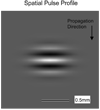Observer efficiency in discrimination tasks simulating malignant and benign breast lesions imaged with ultrasound
- PMID: 16468454
- PMCID: PMC2715171
- DOI: 10.1109/TMI.2005.862205
Observer efficiency in discrimination tasks simulating malignant and benign breast lesions imaged with ultrasound
Abstract
We investigate and extend the ideal observer methodology developed by Smith and Wagner to detection and discrimination tasks related to breast sonography. We provide a numerical approach for evaluating the ideal observer acting on radio frequency (RF) frame data, which involves inversion of large nonstationary covariance matrices, and we describe a power-series approach to computing this inverse. Considering a truncated power series suggests that the RF data be Wiener-filtered before forming the final envelope image. We have compared human performance for Wiener-filtered and conventional B-mode envelope images using psychophysical studies for 5 tasks related to breast cancer classification. We find significant improvements in visual detection and discrimination efficiency in four of these five tasks. We also use the Smith-Wagner approach to distinguish between human and processing inefficiencies, and find that generally the principle limitation comes from the information lost in computing the final envelope image.
Figures







References
-
- Barrett HH. Objective assessment of image quality: effects of quantum noise and object variability. J Opt Soc Am A. 1990;7(7):1266–1278. - PubMed
-
- Wagner RF, Barrett HH. Quadratic tasks and the ideal observer. Proc. SPIE. 767:1–4.
-
- Wagner RF. Low contrast sensitivity of radiologic, CT, nuclear medicine and ultrasound medical imaging systems. IEEE Trans. Med. Imag. 1983;vol MI-2:105–121. - PubMed
-
- Barrett HH, Abbey CK, Clarkson' E. Objective assessment of image quality. III. ROC metrics, ideal observers, and likelihood-generating functions. J Opt Soc Am A. 1998;15(6):1520–1535. - PubMed
-
- Wagner RF, Smith SW, Sandrik JM, Lopez H. Statistics of speckle in ultrasound B-scans. IEEE Trans. Sonics Ultrason. 1983;vol. SU-30:156–163.
Publication types
MeSH terms
Grants and funding
LinkOut - more resources
Full Text Sources
Other Literature Sources
Medical

